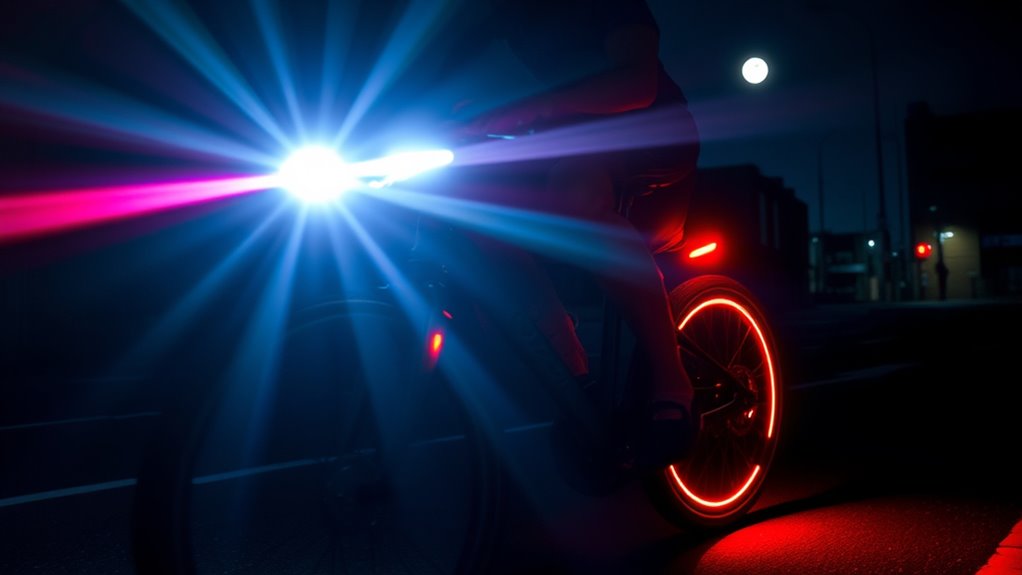To stay safe and visible during night rides, you need proper bicycle lighting that meets legal standards and suits your journey. Use a bright front white light and a rear red light or reflector, and consider flashing modes for extra visibility. Regularly clean and check your lights to keep them effective. Mount them securely in the correct position for maximum brightness. Keep exploring to discover more tips that make night riding safer and more enjoyable.
Key Takeaways
- Proper bicycle lighting enhances rider visibility and alerts others, reducing collision risks during night or low-light conditions.
- Using compliant front and rear lights, including reflectors, is legally required for safe night riding.
- Regular maintenance and cleaning of lights ensure optimal brightness, battery life, and reliable performance.
- Correct mounting position and hardware checks prevent lights from dislodging or impairing visibility.
- Wearing high-visibility gear and controlling speed further improve safety and awareness during night rides.
Understanding the Importance of Proper Bicycle Lighting

Proper bicycle lighting is essential for your safety on the road, especially when riding in low-light or nighttime conditions. Good lighting improves urban visibility, helping you see obstacles and spot hazards early. It also makes you more noticeable to drivers, pedestrians, and other cyclists, reducing the risk of accidents. Lesser-known spots often provide better lighting conditions and fewer distractions, making nighttime rides more enjoyable and safer. Without proper lighting, you become nearly invisible in the dark, increasing your chances of collisions. Using front and rear lights signals your presence and intentions clearly, especially in busy city environments. Consistent use of quality bicycle lights enhances accident prevention, giving you a safer ride and peace of mind. Remember, well-lit bicycles are easier for others to see, making your nighttime rides safer and more enjoyable. Proper lighting is a simple yet vital safety measure, and investing in reliable bicycle lights can significantly improve your visibility. Additionally, choosing lights with aesthetic design can complement your bike’s overall look while ensuring safety. Incorporating effective illumination technology can further enhance your visibility during night rides, especially as advancements in automation technology continue to improve lighting efficiency and functionality.
Types of Bicycle Lights and Their Functions
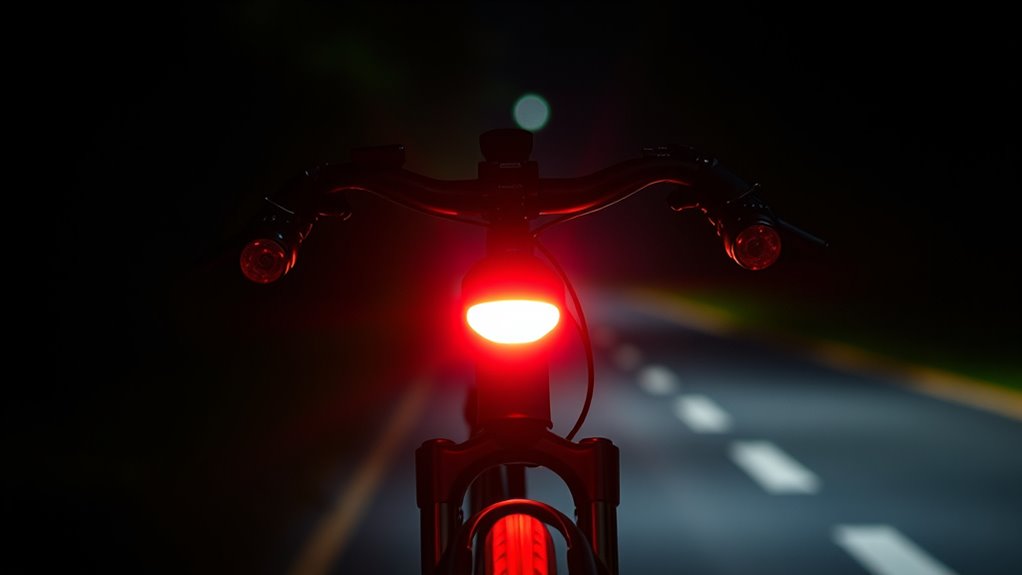
Have you ever wondered which bicycle lights are best for your riding needs? Different types include front lights, rear lights, and combo units, each serving specific functions. Front lights often feature various beam patterns, like wide floodlights for peripheral visibility or focused beams for distance. Rear lights generally emphasize visibility with steady or flashing modes to alert drivers. Battery types vary, with options like disposable batteries, rechargeable lithium-ion, or USB-powered lights, offering convenience and longer life. Brightness levels and beam patterns directly impact your visibility and safety, so choosing the right combination depends on your riding environment. Additionally, some bicycle lights are equipped with smart features such as app control and scheduling to enhance safety and convenience. When selecting lights, considering their durability and resistance to weather conditions can further ensure safety during night riding. Moreover, understanding light placement can help optimize your overall visibility and safety on the road. Proper installation and regular maintenance of your lights are essential for consistent performance. Being aware of battery options can help you choose lights that match your riding frequency and charging preferences. Understanding these options helps you select lights that maximize safety without sacrificing battery life or beam efficiency.
How to Choose the Right Lights for Your Needs
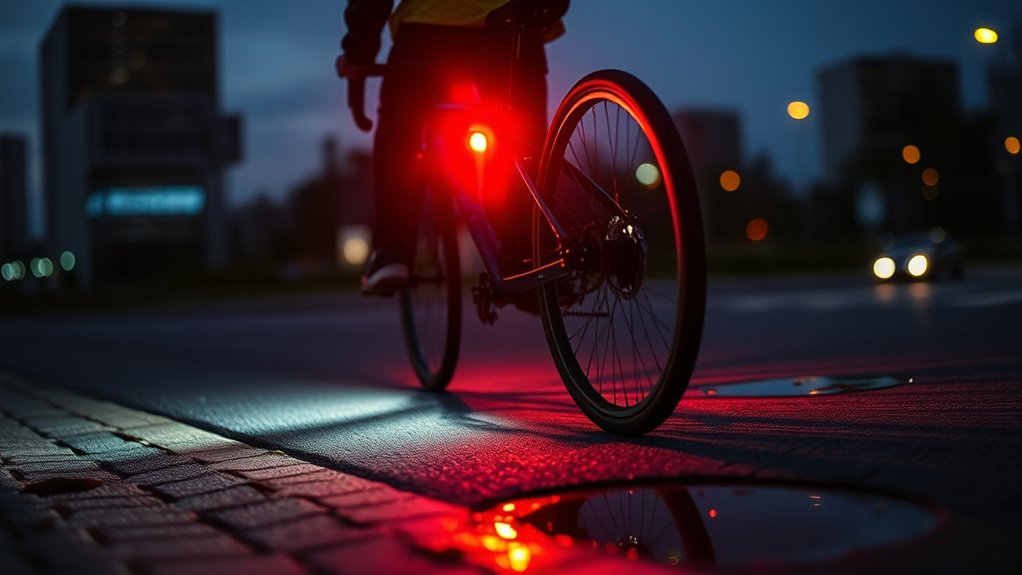
Choosing the right bicycle lights depends on your riding environment and safety priorities. Consider these factors:
- Battery life: Opt for lights with enough battery capacity to last your typical ride, especially if you ride long distances or during extended night hours. Longer battery life ensures consistent illumination without frequent replacements or recharging.
- Beam intensity: Choose a light with sufficient beam strength to illuminate your path clearly and make you visible to others. A higher lumen output ensures better visibility in dark conditions.
- Environment: For urban riding, focus on visibility and signals; for off-road, prioritize brighter, wide beams. Understanding the contrast ratio of your lights can also affect how well you see in varying lighting conditions.
- Mode options: Select lights with multiple modes, such as steady and flashing, to adapt to different conditions and conserve battery.
- Additionally, essential oils can promote relaxation and alertness, helping you stay focused during your night rides. Being aware of lighting technology advances can also help you choose more efficient and reliable lighting solutions.
Installation and Maintenance Tips for Optimal Performance
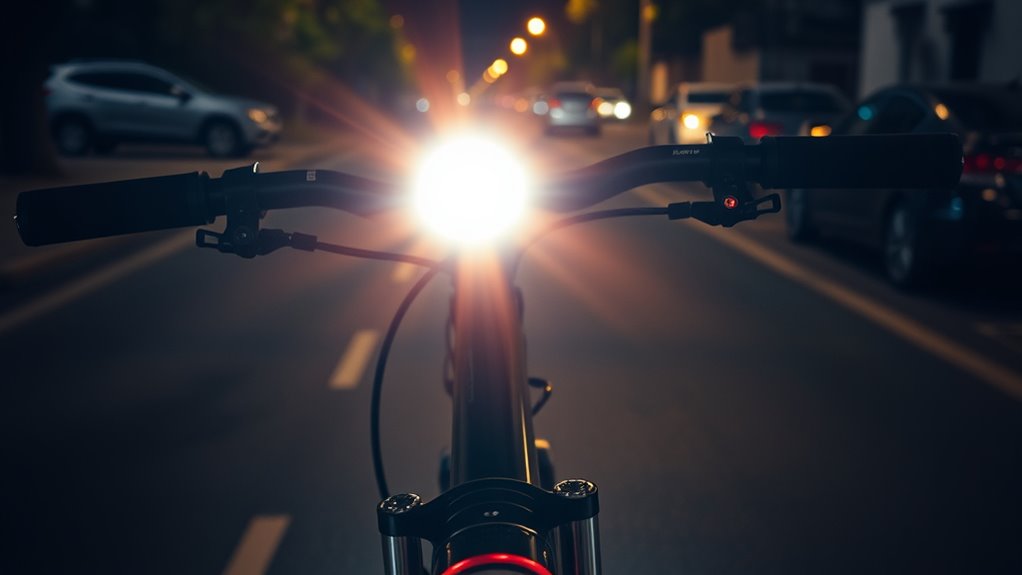
To get the best performance from your bicycle lights, you need to make certain they’re properly mounted. Keep your lights clean by regularly wiping off dirt and debris to maintain brightness. Incorporating sound vibrations or frequency-based techniques can be used to optimize your bike’s lighting system for better visibility and performance. Additionally, understanding city dynamics can help you choose the most effective lighting setup for your specific riding environment. Regularly checking your lights’ smart capabilities ensures they adapt well to changing conditions and improve your safety during night rides. Moreover, considering Kia tuning insights into vehicle modifications can inspire innovative approaches to optimizing your bike’s lighting system for various environments. Exploring fabric decorating markers can also be useful for personalizing your bike accessories, making your setup more visible and unique during night rides.
Proper Mounting Techniques
Proper mounting of bicycle lights is essential to guarantee they function effectively and keep you visible on the road. Correct positioning ensures maximum brightness and safety. First, set the mounting height so the light is level with your line of sight, avoiding glare for others. Second, adjust the strap tension firmly but not overly tight, preventing movement during rides. Third, ensure the light is aligned straight ahead for optimal illumination and visibility. Fourth, periodically check the mounting hardware for wear or looseness, especially after rough terrains. Properly secured lights reduce the risk of dislodging and improve overall performance. Additionally, understanding the importance of proper mounting techniques can help you stay motivated and confident during night rides, especially if you’re facing challenges or feeling uncertain about safety. Maintaining correct installation practices also supports the longevity of your gear and ensures consistent lighting. Regular inspections of mounting hardware help prevent unexpected failures during rides, and staying aware of lighting performance can motivate you to keep your equipment in top condition.
Regular Cleaning Routines
Regular cleaning of your bicycle lights is essential for maintaining their brightness and reliability. Dirt, grime, and moisture can diminish visibility and reduce battery lifespan. Establish a regular cleaning schedule—at least once a month—to keep lights functioning at their best. Use a soft cloth and mild soap to wipe surfaces, avoiding harsh chemicals that may damage components. Consider the table below to understand how cleaning impacts performance and battery health:
| Cleaning Frequency | Effect on Brightness | Battery Lifespan Impact | Recommended Action |
|---|---|---|---|
| Weekly | Maintains maximum brightness | Extends battery lifespan | Quick wipe-down after rides |
| Monthly | Prevents buildup | Preserves battery health | Deep cleaning and checks |
| Quarterly | Minimal dirt accumulation | Slight effect | Inspect and clean thoroughly |
| Annually | Rarely needed | No impact | Complete system check |
Sticking to a consistent cleaning routine ensures your lights stay bright and reliable on every ride. Proper maintenance practices can also enhance overall safety and extend the lifespan of your bicycle lighting system.
Legal Requirements and Safety Regulations

Understanding and following legal requirements and safety regulations for bicycle lighting is essential for staying compliant and guaranteeing your safety on the road. Traffic laws often specify mandatory lighting equipment, such as front white lights and rear red reflectors or lights, to improve visibility.
Failing to meet safety standards can result in fines or accidents. To stay compliant, consider these key points:
- Use lights that meet local safety standards for brightness and durability.
- Ensure your front light is visible from at least 500 feet away.
- Keep rear lights and reflectors functional and clean.
- Use appropriate lighting during night rides or low visibility conditions.
Adhering to these regulations helps you avoid penalties and greatly enhances your safety during night riding.
Innovative Lighting Technologies and Trends
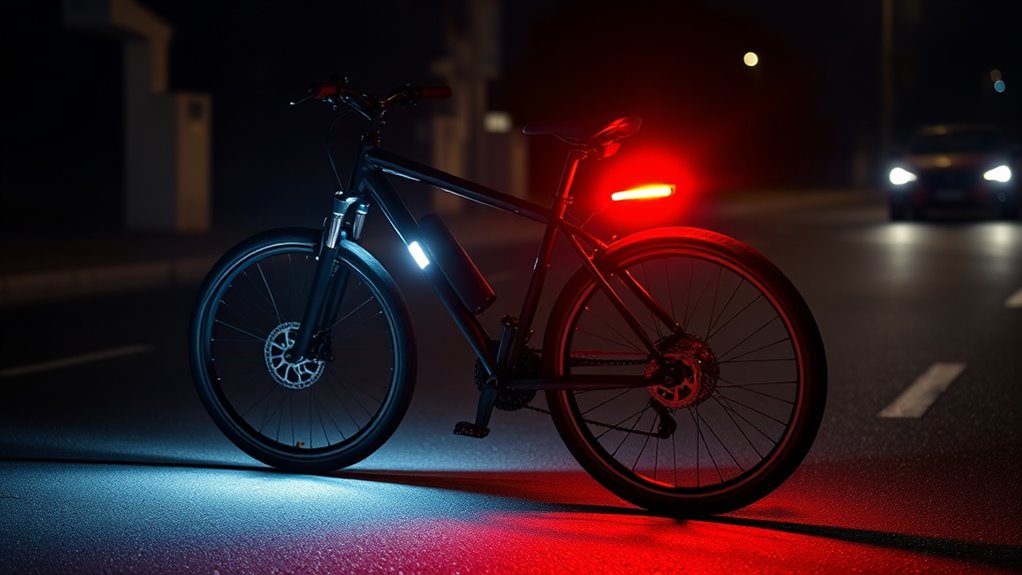
Smart lighting systems are transforming how you see and be seen on the road. They offer features like automatic brightness adjustments and connectivity with your smartphone.
Solar-powered devices are gaining popularity, providing eco-friendly options that charge during daylight hours. These innovations make your bike lighting more efficient, sustainable, and easier to manage.
Smart Lighting Systems
Innovative lighting technologies are transforming bicycle illumination by offering smarter, more adaptive solutions. Smart lighting systems leverage sensor integration to detect environmental conditions and rider movements, adjusting brightness automatically. This adaptive brightness ensures you stay visible without blinding others or wasting battery.
These systems often include features like motion sensors that activate lights when you start riding or decelerate, and ambient light sensors that modify brightness based on surroundings. Advanced options also connect to your smartphone, enabling real-time control and customization.
Here are four key innovations:
- Sensor integration for automatic adjustments
- Adaptive brightness based on ambient light
- Motion-activated lighting for efficiency
- Wireless connectivity for remote control
These technologies enhance safety while streamlining your riding experience.
Solar-Powered Devices
Harnessing the power of the sun, solar-powered bicycle lighting offers a sustainable and maintenance-free alternative to traditional systems. Solar lanterns attach easily to your bike, utilizing sunlight during the day to provide bright illumination at night. They’re lightweight, eco-friendly, and require no batteries or wiring, reducing hassle and environmental impact.
Solar chargers ensure your devices stay powered on long rides, letting you recharge your phone or GPS without needing external power sources. Some solar lighting setups combine lanterns and chargers, creating a versatile system for safety and connectivity.
As technology advances, these devices become more efficient, affordable, and compact, making solar-powered lighting an appealing option for eco-conscious cyclists who want reliable visibility and a simplified riding experience.
Tips for Safe Night Riding Practices

Riding your bicycle safely at night requires more than just turning on your lights; it involves adopting specific practices to maximize visibility and reduce risks. To stay safe, focus on your cycling fitness and choose well-lit bike touring routes.
Safe night biking combines proper lighting, visibility gear, controlled speed, and awareness for enjoyable, hazard-free rides.
Here are some tips:
- Always perform a quick check of your lights and reflectors before riding.
- Wear high-visibility clothing and use reflective gear to catch drivers’ attention.
- Keep your speed moderate, especially if your cycling fitness isn’t at peak, to allow quick reactions.
- Stay alert and avoid distractions, making sure you’re aware of your surroundings and potential hazards.
Following these practices helps you enjoy night rides safely while increasing your visibility and reducing accidents.
Frequently Asked Questions
How Do Battery Life and Recharge Times Vary Across Different Bike Lights?
When evaluating bike lights, you notice that battery longevity and recharge speed vary widely. Some models offer long-lasting batteries that run for hours, while others have shorter battery life.
Recharge speed also differs; fast-charging lights can be ready in less than an hour, whereas others take several hours.
Knowing these differences helps you pick a light that fits your riding habits, ensuring you stay visible and safe during night rides.
Are There Specific Lighting Standards for Different Countries or Regions?
Think of international regulations and regional standards like different traffic laws—each region has its own rules.
For bike lights, countries set standards to guarantee safety and visibility, such as brightness levels or flashing modes. For example, the EU and US have specific regulations to promote rider safety.
Always check your local guidelines before buying or installing lights to stay compliant and keep safe during night rides.
How Can I Ensure My Lights Are Visible in Inclement Weather Conditions?
To guarantee your lights stay visible in bad weather, look for ones with rain resistance and fog visibility features.
You should regularly check that your front and rear lights are clean and functioning properly.
Use high-visibility modes during fog or heavy rain, and consider adding reflective tape or accessories for extra safety.
Properly maintained, weather-resistant lights will boost your visibility, keeping you safer on the road during inclement conditions.
What Are the Best Practices for Mounting Lights on Various Bicycle Types?
When mounting lights on your bike, consider the bike frame compatibility and ideal mounting positions.
For road bikes, attach lights on the handlebars and seat post for clear visibility.
Mountain bikes benefit from mounting on the handlebar and rear rack, while cruisers may need clip-on mounts.
Always guarantee the lights are secure, unobstructed, and aligned correctly to maximize visibility in various riding conditions.
Can Smart Lighting Systems Sync With Other Safety Devices or Apps?
Imagine your safety as a lighthouse guiding you through darkness. Smart lighting systems now harness wireless connectivity and app integration to sync seamlessly with other safety devices.
You can enhance visibility, alert others, and respond quickly to changing conditions. These connected systems act as your digital lighthouse, illuminating your path and strengthening your safety network, so you ride confidently through night shadows knowing your lights work in harmony with your safety ecosystem.
Conclusion
By investing in the right bicycle lights, you considerably boost your visibility and safety—reducing nighttime accidents by up to 50%. With proper installation and awareness of legal requirements, you can enjoy confident night rides. Stay updated on innovative lighting trends to enhance your safety further. Remember, well-lit bikes are not just a legal obligation but a smart choice for a safer cycling experience. Prioritize your visibility, and ride with confidence after dark.
